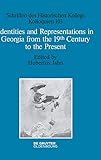Identities and Representations in Georgia from the 19th Century to the Present / ed. by Hubertus Jahn.
Material type: TextSeries: Schriften des Historischen Kollegs : Kolloquien ; 103Publisher: München ; Wien : De Gruyter Oldenbourg, [2020]Copyright date: ©2021Description: 1 online resource (XII, 194 p.)Content type:
TextSeries: Schriften des Historischen Kollegs : Kolloquien ; 103Publisher: München ; Wien : De Gruyter Oldenbourg, [2020]Copyright date: ©2021Description: 1 online resource (XII, 194 p.)Content type: - 9783110659276
- 9783110659559
- 9783110663600
- online - DeGruyter
- Issued also in print.
| Item type | Current library | Call number | URL | Status | Notes | Barcode | |
|---|---|---|---|---|---|---|---|
 eBook
eBook
|
Biblioteca "Angelicum" Pont. Univ. S.Tommaso d'Aquino Nuvola online | online - DeGruyter (Browse shelf(Opens below)) | Online access | Not for loan (Accesso limitato) | Accesso per gli utenti autorizzati / Access for authorized users | (dgr)9783110663600 |
Frontmatter -- Table of content -- Acknowledgements -- Notes on transliteration and spelling -- List of abbreviations -- Introduction -- Past and future of the Stalin museum in Gori -- Soviet, national, local? Representations and perceptions of Joseph Stalin as a political and cultural figure in Gori -- Historical debates and the Likhni declaration as a decisive event in the Georgian-Abkhaz conflict -- The liminal: Colonial identity on the margins of an empire -- National identity and perceptions of citizenship in Georgia over the last decade -- Georgian nationalism and Soviet power. Between accommodation and revolt -- Meaningless people. Atheism, subjectivity and unrepresented identities in Georgia -- Iakob Gogebashvili and the natural method. Textbooks, modernity and nationalism in the late tsarist periphery -- Old saints and new anxieties. Sainthood and nationhood in modern Georgia -- Georgian political romanticism in the Caucasus -- The women’s question in the late 19th and early 20th centuries and Georgia’s national movement -- Visits of tsars to the Caucasus as representations of empire -- List of contributors -- Index of persons
restricted access online access with authorization star
http://purl.org/coar/access_right/c_16ec
This interdisciplinary volume explores various identities and their expressions in Georgia from the early 19th century to the present. It focuses on memory culture, the politics of history, and the relations between imperial and national traditions. It also addresses political, social, cultural, personal, religious, and gender identities. Individual contributions address the imperial scenarios of Russia’s tsars visiting the Caucasus, Georgian political romanticism, specific aspects of the feminist movement and of pedagogical reform projects before 1917. Others discuss the personality cult of Stalin, the role of the museum built for the Soviet dictator in his hometown Gori, and Georgian nationalism in the uprising of 1956. Essays about the Abkhaz independence movement, the political role of national saints, post-Soviet identity crises, atheist sub-cultures, and current perceptions of citizenship take the volume into the contemporary period.
Issued also in print.
Mode of access: Internet via World Wide Web.
In English.
Description based on online resource; title from PDF title page (publisher's Web site, viewed 28. Feb 2023)


